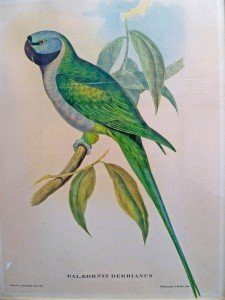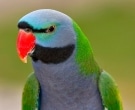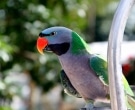Content |
|---|
Description:
50 cm.. of length and a weight of 320 g..
The Derbyan Parakeet (Psittacula derbiana) has the crown and lower cheeks lavender blue with pale iridescent blue shading on the forecrown and pale green bright in the upper cheeks and periophthalmic region; narrow black stripe that extends horizontally from the eyes to the area above the bill; spacious malar stripes (“moustache“) Black fuse next to the chin to create a great patch.
Since the nape until uppertail-coverts green, bright in the the mantle. Upperwing-coverts Green with yellow or marginalized feathers with yellow in median and greater coverts, creating distinct pale patch. The primaries and secondaries emerald green.
The underparts to belly lavender-bue; the thighs, vent and undertail-coverts grass-green. Uppertail centrally blue, outer feathers Blue in vane outer, green on inner.
upper jaw red tipped yellow, the lower black; cere blue-gray, irises straw-colored; legs dark grey.
The female has the bill black.
The immature they have the head green and the underparts much paler.
The very young birds has bill pink, turning black later and then red again in males.
- Sound of the Derbyan Parakeet.
Habitat:
Observed in forest, between 1.250 and 4.000 meters above sea level. It is thought that you can make vertical migration seasonal. Views in the Tibet in 3.300 m, even in winter.
According to reports, have priority for coniferous forests or mixed forests of Pinus and Quercus, also of Alpine growth as the rhododendron. Visit valleys culture, especially during harvest.
Gregaria, usually seen in noisy flocks of up to several dozen birds. Only rarely are in pairs or individually.
Reproduction:
Holes for their nests they are located in tree hollows, usually at a certain height, commonly in a himalayan poplar Populus ciliata.
The breeding they performed it during the month of June.
The put in captivity is between 2 and 5 eggs.
Food:
Reported foods include barley, the corn, catkins of Populus ciliata, cones of Pinus tabulaefornis and fruit grown according to availability, including peaches; they can be highly destructive crops. It is believed that they may eat some invertebrates, Hoja-brotes and berries.
Distribution:
Distributed by the Of the Himalayas and South of the Tibetan plateau. Since Arunachal Pradesh and Assam, India, to the southeast of Tibet and Southwest China in Sichuan Western fence of 32 °N and west of Yunnan to the South up to around Tengchong to 25 ° N.
Visitors during the summer in the northeast of the India (May-September). Resident elsewhere, apparently with some seasonal altitudinal movements.
Usually common. Live birds traded in small numbers with a modest population captive outside their area of distribution.
Conservation:
State of conservation ⓘ |
||
|---|---|---|
 Near Threatened ⓘ (UICN)ⓘ
Near Threatened ⓘ (UICN)ⓘ
| ||
• Current Red List of UICN: Near-threatened
• Population trend: Decreasing
The population of the Derbyan Parakeet It is suspected that it may be suffering a moderately rapid decline mainly due to the pressure that is subjected , not only due to its continuous capture for the cage bird trade, but also by the indiscriminate felling of trees in the nest, together with evidence of local extinctions and declining birds in some parts of its area of distribution.
Threats:
-
– This species was previously threatened by deforestation campaigns, that it resulted in, loss of much of their breeding habitat; However, This threat ended in the Decade of 1990 (Zeidler and Francis 2011).
– Today, Middle-aged trees, some of which provide the perfect place for the construction of the nest, they are being felled for the construction of housing and firewood, even in protected forests (Zeidler and Francis 2011).
– Recent observations indicate that this species is subject to a strong pressure catch and the collection of eggs for the pet trade (J. Eaton in litt. 2010, Zeidler and Francis 2011).
– The collection of eggs and subsequent incubation, for the breeding of Derby Parrots and subsequent sale, is very organized in some areas (Zeidler and Francis 2011).
– The species is sold openly and are kept, in large numbers, as a pet in its natural distribution area (J. Eaton in litt. 2010, J. Hornskov in litt. 2010, Zeidler and Francis 2011).
Actions of conservation in CITES Appendix II course.:
-
– Is listed in Schedule I of the law of 1972 for nature (Protection) on India (The India Government, 1993) and the collection for the pet trade is illegal in China (Zeidler and Francis 2011).
– In some areas, as the Shachong valley (Szechwan), the monks provide protection for wildlife, including trap activities (Zeidler and Francis 2011).
Conservation Actions Proposed:
-
– Population trends and monitor hunting pressure.
– Addressing the threat of trade through the application of the legislation and awareness-raising activities.
– Steadily increase the number of sites that are protected.
– Support monks engaged in activities for the protection of wildlife (Zeidler and Francis 2011).
– Evaluate the effectiveness of a scheme of nest boxes (Zeidler and Francis 2011).
"Derbyan Parakeet" in captivity:
The Derbyan Parakeet is a pet very popular at the local level due to the wonderful color of its plumage, his intelligence and its excellent speaking skills, that distinguishes it from other Asian parrots, usually you do not have that voice clarity.
While these parrots do not have the ability to learn an extensive vocabulary, his manner of speaking looks like the speech of Amazon parrots. Having said that, there are never guarantees that a Derbyan Parakeet you will learn to speak, but most do – even the females.
It is a bird that needs much stimulation. She loves to chew and can be very destructive, provided that provide it a variety of toys to chew, It will inhibit its destructive behavior and avoid his boredom.
It is a species with demand among farmers for several reasons, including its striking plumage, its ease of reproduction and its excellent parenting skills.
The Derby Parrot reach sexual maturity between the 2 and 3 years of age. It reported that it may reach sexual maturity later in nature, possibly to the 5 years.
The typical breeding season It will begin in April or June and average clutch sizes are of 2 – 4 eggs. The incubation period lasts 23 – 28 days, and the chicks leave the nest to the 8 to 9 weeks of age.
The Derbyan Parakeet It must be kept in an Aviary, or in a large cage, providing a daily time flying out. They are social birds and like to be “part of a flock” – which could be a group of birds in an aviary environment or a human family.
It requires much interaction to keep its meekness. By nature, it is a shy bird to human contact, Although considered usually placid compared to some other parrots.
If they are kept outdoors they may require periodic deworming – since they spend considerable time at the bottom of your aviaries or cages. Because of this habit, they are also susceptible to fungal infections. Good hygiene is especially important to keep healthy this Parrot.
Even so, the Derby Parakeet is a rare bird outside its range and with limited breeding.
Alternative names:
– Derbyan Parakeet, Chinese Parakeet, Lord Derby’s Parakeet, Upper Yangtze Parakeet (English).
– Perruche de Derby (French).
– Chinasittich (German).
– Periquito-da-china (Portuguese).
– Cotorra de Derby, Cotorra Verde China (español).
scientific classification:
– Order: Psittaciformes
– Family: Psittaculidae
– Genus: Psittacula
– Scientific name: Psittacula derbiana
– Citation: (Fraser, 1852)
– Protonimo: Palaeornis Derbianus
Derbyan Parakeet images:
Videos "Derbyan Parakeet"
Derbyan Parakeet (Psittacula derbiana)
Sources:
– Avibase
– Parrots of the World – Forshaw Joseph M
– Parrots A Guide to the Parrots of the World – Tony Juniper & Mike Parr
– Birdlife
– Photos:
(1) – A pair of Lord Derby’s Parakeet (also known as Derbyan Parakeet)s at Wilhelma Zoo, Stuttgart, Germany By krislorenz (_DSC2098Uploaded by Snowmanradio) [CC BY-SA 2.0], via Wikimedia Commons
(2) – A male Derbyan Parakeet (also known as Lord Derby’s Parakeet) in Hangzhou, Zhejiang, China By Michael Vito from South Orange, NJ, USA (Hangzhou RevisitedUploaded by Snowmanradio) [CC BY-SA 2.0], via Wikimedia Commons
(3) – An adult male Derbyan Parakeet at Shenlong Eco Park, People’s Republic of China By Doug Janson (Own work) [CC BY-SA 3.0 or GFDL], via Wikimedia Commons
(4) – A male Lord Derby’s Parakeet (also known as Derbyan Parakeet) in an aviary By Richard J. Blach (Own work (Original text: eigene Fotografie)) [GFDL or CC-BY-SA-3.0], via Wikimedia Commons
(5) – Derbyan Parakeet (Psittacula derbiana) at Wellington Zoo, New Zealand. A male bird showing red beak by Peter Halasz – Wikipedia
(6) – Psittacula derbiana, drawing from nature by J. Gould & H.C. Richter By JoJan (Own work) [CC BY 3.0], via Wikimedia Commons
– Sounds: jon hornbuckle (Xeno-canto)






